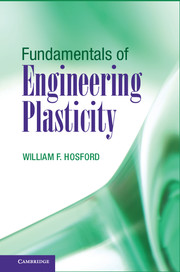Book contents
- Frontmatter
- Contents
- Preface
- 1 An Overview of the History of Plasticity Theory
- 2 Yielding
- 3 Stress and Strain
- 4 Isotropic Yield Criteria
- 5 Bounding Theorems and Work Principles
- 6 Slip-Line Field Theory
- 7 Anisotropic Plasticity
- 8 Slip and Dislocations
- 9 Taylor and Bishop and Hill Models
- 10 Pencil Glide Calculations of Yield Loci
- 11 Mechanical Twinning and Martensitic Shear
- 12 Effects of Strain Hardening and Strain-Rate Dependence
- 13 Defect Analysis
- 14 Effects of Pressure and Sign of Stress State
- 15 Lower-Bound Models
- 16 Plasticity Tests
- Index
- References
6 - Slip-Line Field Theory
Published online by Cambridge University Press: 05 June 2013
- Frontmatter
- Contents
- Preface
- 1 An Overview of the History of Plasticity Theory
- 2 Yielding
- 3 Stress and Strain
- 4 Isotropic Yield Criteria
- 5 Bounding Theorems and Work Principles
- 6 Slip-Line Field Theory
- 7 Anisotropic Plasticity
- 8 Slip and Dislocations
- 9 Taylor and Bishop and Hill Models
- 10 Pencil Glide Calculations of Yield Loci
- 11 Mechanical Twinning and Martensitic Shear
- 12 Effects of Strain Hardening and Strain-Rate Dependence
- 13 Defect Analysis
- 14 Effects of Pressure and Sign of Stress State
- 15 Lower-Bound Models
- 16 Plasticity Tests
- Index
- References
Summary
INTRODUCTION
Slip-line field analysis involves plane-strain deformation fields that are both geometrically self-consistent and statically admissible. Therefore, the results are exact solutions. Slip lines are really planes of maximum shear stress and are oriented at 45 degrees to the axes of principal stress. The basic assumptions are that the material is isotropic and homogeneous and rigid-ideally plastic (that is, no strain hardening and that shear stresses at interfaces are constant). Effects of temperature and strain rate are ignored.
Figure 6.1 shows a very simple slip-line field for indentation. In this case, the thickness, t, equals the width of the indenter, b and both are very much smaller than w. The maximum shear stress occurs on lines DEB and CEA. The material in triangles DEA and CEB is rigid. Although the field must change as the indenters move closer together, the force can be calculated for the geometry as shown. The stress, σy, must be zero because there is no restrain to lateral movement. The stress, σz, must be intermediate between σx and σy. Figure 6.2 shows the Mohr's circle for this condition. The compressive stress necessary for this indentation, σx = −2k. Few slip-line fields are composed of only straight lines. More complicated fields are considered throughout this chapter.
- Type
- Chapter
- Information
- Fundamentals of Engineering Plasticity , pp. 47 - 67Publisher: Cambridge University PressPrint publication year: 2013
References
- 2
- Cited by



